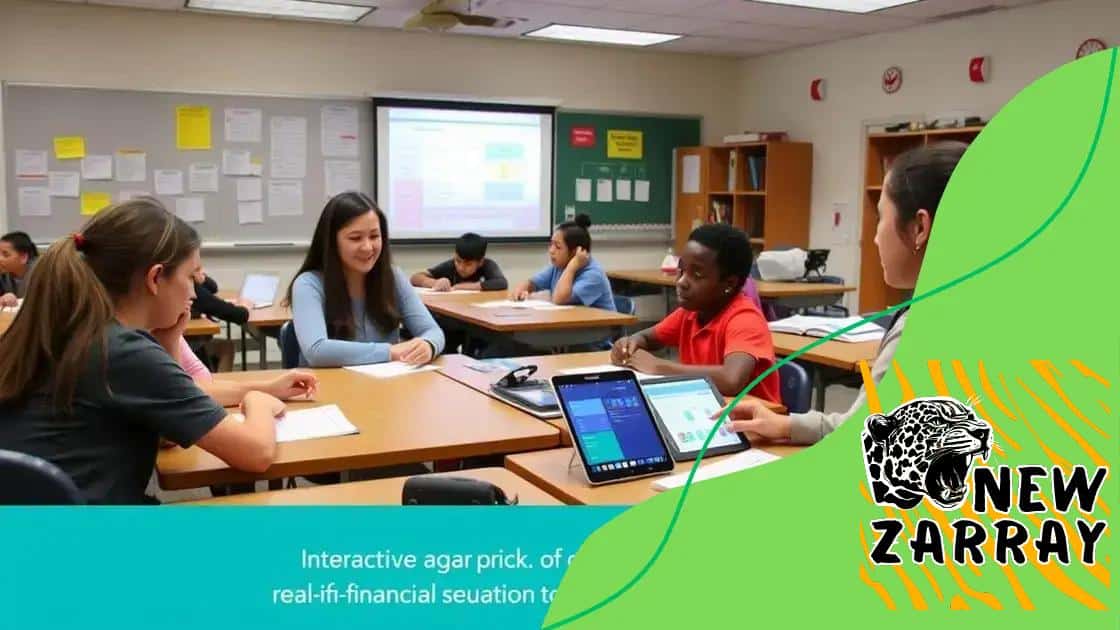Financial literacy courses for middle and high school students

Financial literacy courses for middle and high school students equip them with essential money management skills, preparing them for a successful financial future through engaging methods and practical applications.
Financial literacy courses for middle and high school students are becoming crucial as they equip young learners with the necessary skills to manage their finances wisely. Have you considered how these skills could shape their futures?
Importance of financial literacy
Understanding financial literacy is essential for students today. In a world where money plays a huge role, knowing how to manage it can make a significant difference in their lives.
Why is Financial Literacy Important?
The benefits of learning about finances extend beyond school. Students equipped with financial literacy skills feel more confident when making decisions related to money. They are better prepared for real-life situations such as budgeting and saving.
Core Concepts of Financial Literacy
Some key concepts include:
- Budgeting: Knowing how to plan and track spending.
- Saving: Understanding the importance of saving for the future.
- Investing: Learning how to grow money over time.
- Debt management: Managing loans and credit effectively.
By exploring these ideas, students can find financial success. This knowledge helps reduce anxiety about money and promotes healthy financial habits from a young age.
Moreover, discussing financial literacy in schools encourages students to think critically about their spending and saving habits. When they understand these concepts, they are likely to make informed financial choices. Engaging in conversations about money also prepares them to navigate financial challenges in life.
In conclusion, fostering financial literacy is crucial. It empowers students, equipping them with knowledge that shapes their futures positively. When they learn to manage their finances wisely, they pave the way for greater financial well-being.
Key topics in financial literacy courses
Understanding key topics in financial literacy courses is vital for students. These subjects provide a foundation for making informed decisions about money. Let’s explore the essential areas covered in these courses.
Budgeting Basics
Budgeting is a crucial skill that helps students manage their income and expenses. Learning to create a budget allows them to track where their money goes. It’s like having a roadmap for their finances, ensuring they live within their means.
Saving Strategies
Building a habit of saving is essential for financial success. Students learn various saving strategies, including setting goals and choosing the right savings accounts. They understand the importance of saving for emergencies and future investments.
Understanding Credit
Credit plays a significant role in personal finance. In courses, students explore how credit works, the types of credit available, and the responsibilities of borrowing. They learn to build a positive credit history, which is vital for major purchases like cars or homes.
- Types of credit: credit cards, loans, and mortgages
- The impact of credit scores on financial opportunities
- Managing debt responsibly to prevent financial crises
Investing is another important topic. Students are introduced to the concept of investing and how it can grow their wealth over time. They learn about stocks, bonds, and mutual funds. This knowledge helps them see that making their money work for them is a possibility.
Risk management is also discussed in these courses. Students learn how to assess risks and make decisions that protect their financial future. Understanding insurance and how to choose the right type helps them safeguard their assets.
These key topics in financial literacy courses equip students with knowledge that they will use throughout their lives. Knowing how to budget, save, manage credit, and invest is vital for becoming financially responsible adults.
How schools can implement these courses

Implementing financial literacy courses in schools requires careful planning and collaboration. It’s important to consider the needs of students and how best to engage them in learning about finance.
Curriculum Development
Schools can start by developing a well-structured curriculum. This should include essential topics such as budgeting, saving, investing, and managing credit. Additionally, it’s beneficial to align the curriculum with existing educational standards to ensure it complements other subjects.
Engaging Teaching Methods
Using interactive and engaging teaching methods enhances learning. Incorporating activities such as role-playing, games, and real-world scenarios helps students grasp complex financial concepts. By making the learning experience fun, interest in financial literacy will likely grow.
Professional Development for Teachers
Teachers need proper training and resources to effectively teach financial literacy. Schools can offer professional development workshops focusing on financial topics and teaching strategies. This preparation builds teachers’ confidence and ensures they feel equipped to deliver the content.
- Providing resources like lesson plans and teaching materials
- Creating a supportive network for educators to share best practices
- Inviting guest speakers from the finance industry to inspire students
Collaboration with local businesses and financial institutions can greatly enrich the program. Partnerships can provide funding, resources, and real-world applications of financial concepts. This connection between theory and practice makes learning more relevant.
Schools can also promote family involvement in the learning process. Hosting workshops or information sessions for parents can strengthen the importance of financial literacy at home. When families participate, students are more likely to practice what they learn in school.
Finally, schools should regularly assess the effectiveness of their courses. Gathering feedback from students, teachers, and parents can highlight areas for improvement. By monitoring progress, schools can ensure they provide valuable education in financial literacy.
Engaging students in financial education
Engaging students in financial education is crucial for fostering a lifelong understanding of money management. To make these courses appealing, teachers can incorporate various interactive and fun activities.
Hands-On Activities
One effective way to engage students is through hands-on activities. For example, simulating a budget can help students learn to allocate their money wisely. They can also take part in games that involve real-world financial scenarios, making learning both informative and enjoyable.
Real-Life Applications
Connecting lessons to real-life situations increases relevance. Students can explore how financial concepts apply to their everyday lives. Discussing current events that relate to financial literacy can provide context, helping students understand the impact of financial decisions.
Technology Integration
Using technology is another way to keep students engaged. There are numerous apps and online platforms that teach financial concepts through interactive methods. These tools can provide personalized experiences and allow students to learn at their own pace.
- Online simulators for investing and trading
- Budgeting apps to track expenses
- Webinars and virtual workshops with financial experts
Group projects can also enhance engagement. Assigning students to work in teams to create financial plans encourages collaboration and deeper understanding. They can present their plans to the class, boosting confidence and public speaking skills.
Inviting guest speakers from diverse financial backgrounds can inspire students. Hearing stories from professionals about their experiences and challenges can motivate students to take their financial education seriously. It also opens the door for questions and discussions about future career paths.
Additionally, providing regular feedback helps students stay on track and understand their progress. Teachers can create a supportive environment where students feel comfortable sharing their thoughts on what they learn about financial education. This interaction fosters a community of learners eager to improve their financial skills.
Resources for parents and educators
Providing resources for parents and educators is key to supporting financial literacy initiatives in schools. Accessible materials can empower families to discuss financial concepts at home, reinforcing what students learn in the classroom.
Online Courses and Webinars
Many organizations offer online courses tailored for parents and educators. These courses cover topics like budgeting, saving strategies, and teaching methods. They often include webinars featuring experts who share insights on effective financial education approaches.
Books and Guides
There are numerous books and guides dedicated to financial literacy that families can use. These materials provide practical tips and activities to engage students in learning. Some recommended titles include:
- The Everything Kids’ Money Book – A fun introduction to money management.
- Money Matters for Kids – Offers insights into why saving and budgeting are important.
- Smart Money Smart Kids – A practical guide for parents on teaching their children about money.
Schools can curate a list of recommended resources to distribute to families, ensuring they have the right tools for supporting their children.
Interactive Tools and Apps
Using technology can make learning about finances more engaging. There are many apps designed to teach financial literacy. These apps typically include budgeting tools, interactive games, and quizzes to make learning fun and educational.
Some popular apps include:
- Mint – Helps users track their expenses and manage budgets.
- KidzEarnMoney – Teaches children how to earn and save money through fun activities.
- Stock Market Simulator – Allows students to practice investing in a risk-free environment.
Schools can encourage families to explore these tools together. By doing so, they create opportunities for discussions about money management and financial decision-making.
Finally, hosting community events or workshops focused on financial literacy can greatly benefit families. These gatherings provide a space for parents and educators to collaborate and exchange ideas on teaching financial concepts effectively. Engaging community members will foster a supportive environment for all learners.
FAQ – Frequently Asked Questions about Financial Literacy Education
Why is financial literacy important for students?
Financial literacy helps students make informed decisions about money, preparing them for a successful financial future.
How can parents support financial education at home?
Parents can engage in discussions about budgeting, saving, and spending, and provide resources that reinforce what kids learn in school.
What resources are available for teachers teaching financial literacy?
Teachers can access online courses, books, and interactive tools designed specifically for financial education.
What methods can be used to engage students in financial education?
Hands-on activities, real-life applications, and technology integration are effective ways to make financial literacy engaging for students.





